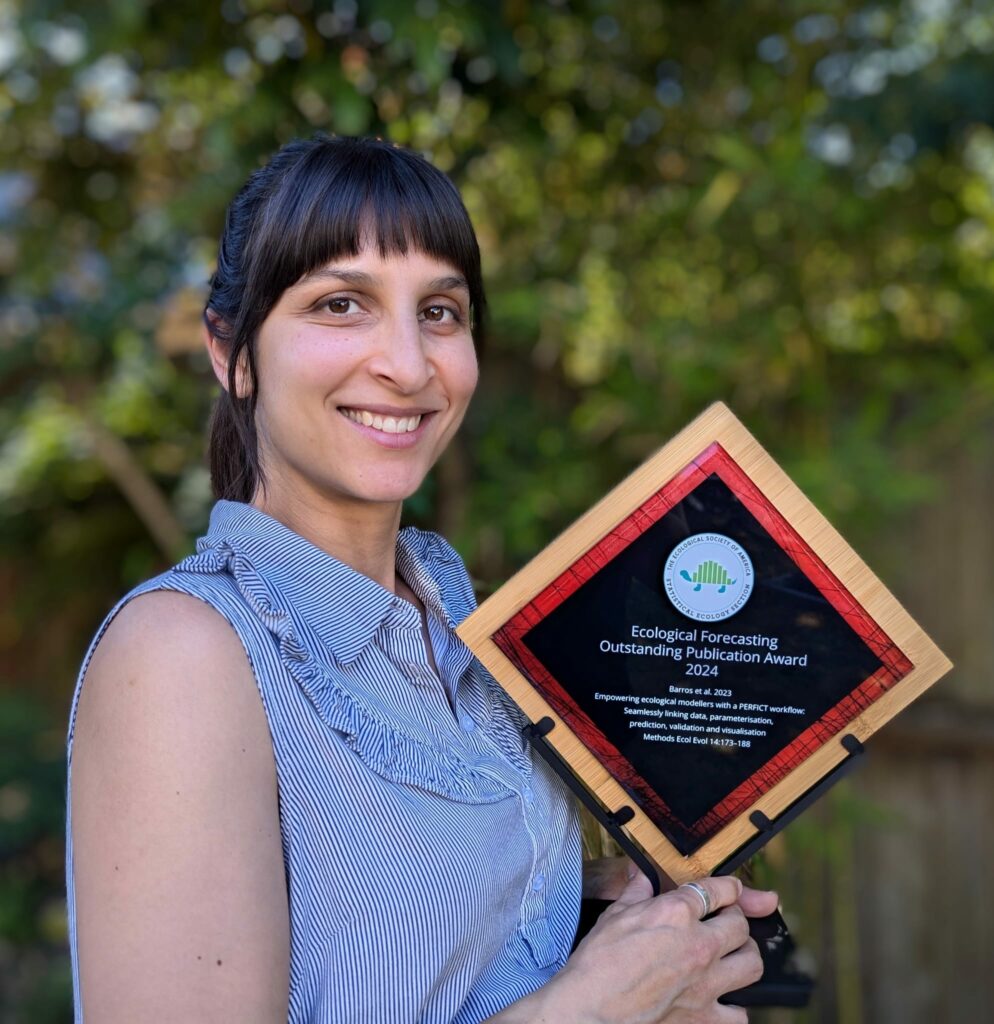The ESA Statistical Ecology section presented the 2024 Ecological Forecasting Outstanding Publication Award to Cerres Barros and co-authors, Yong Luo, Alex Chubaty, Ian Eddy, Tatiane Micheletti, Céline Boisvenue, David Andison, Steven Cumming, & Eliot McIntire, for their 2023 Methods in Ecology and Evolution paper:

The award committee was strongly impressed by the way this paper clearly organized and presented cyberinfrastructure principles that are an increasingly important part of doing ecology well. This paper helps to translate software engineering concepts into clear take home messages that are accessible to ecologists (e.g., predictions depend on workflows, not just models) and draws attention to the need for Interdisciplinary teamwork in successful ecological forecasting. The committee was further impressed by this team’s commitment to developing tools that are accessible, reusable, and multi-purpose, and that address the challenges of operationalizing ecological forecasts.
In addition to an award plaque and prize ($200), this year’s recipient will also receive a £120 credit from Routledge books.
Nominate Papers for the 2025 Award
Individuals wishing to nominate papers published in the past 3 years for the 2025 award are encouraged to do so by the March 1, 2025 deadline. Additional information can be found at https://www.esa.org/stats/awards/ecological-forecasting-outstanding-publication-award/
Full List of Award Winners & Citations
2024 – Cerres Barros (University of British Columbia)
Barros, C., Luo, Y., Chubaty, A. M., Eddy, I. M. S., Micheletti, T., Boisvenue, C., Andison, D. W., Cumming, S. G., & McIntire, E. J. B. (2023). Empowering ecological modellers with a PERFICT workflow: Seamlessly linking data, parameterisation, prediction, validation and visualisation. Methods in Ecology and Evolution, 14, 173–188. https://doi.org/10.1111/2041-210X.14034
2023 – Jacob Zwart (USGS)
Zwart, J.A., Oliver, S.K., Watkins, W.D., Sadler, J.M., Appling, A.P., Corson-Dosch, H.R., Jia, X., Kumar, V., and Read, J.S. 2023. “Near-Term Forecasts of Stream Temperature Using Deep Learning and Data Assimilation in Support of Management Decisions.” JAWRA Journal of the American Water Resources Association 59 (2): 317–37. https://doi.org/10.1111/1752-1688.13093.
2022 – Kelly Heilman (University of Arizona)
Heilman, K.A., Dietze, M.C., Arizpe, A.A., Aragon, J., Gray, A., Shaw, J.D., Finley, A.O., Klesse, S., DeRose, R.J., & Evans, M.E.K. (2022). Ecological forecasting of tree growth: Regional fusion of tree-ring and forest inventory data to quantify drivers and characterize uncertainty. Global Change Biology 28(7):2442-2460 doi.org/10.1111/gcb.16038
2021 – Sarah Saunders (National Audubon Society)
Saunders, S.P., F.J. Cuthbert, and E.F. Zipkin. “Evaluating Population Viability and Efficacy of Conservation Management Using Integrated Population Models.” Journal of Applied Ecology 55, no. 3 (2018): 1380–92. https://doi.org/10.1111/1365-2664.13080.
2020 – Paige Howell (USGS)
Howell, P.E., B.R. Hossack, E. Muths, B.H. Sigafus, A. Chenevert‐Steffler, and R.B. Chandler. “A Statistical Forecasting Approach to Metapopulation Viability Analysis.” Ecological Applications 30, no. 2 (2020): e02038. https://doi.org/10.1002/eap.2038.
2019 – Maria Paniw (CREAF, Ecological and Forestry Applications Research Centre)
Paniw, M., N. Maag, G. Cozzi, T. Clutton-Brock, and A. Ozgul. “Life History Responses of Meerkats to Seasonal Changes in Extreme Environments.” Science 363, no. 6427 (February 8, 2019): 631–35. https://doi.org/10.1126/science.aau5905.
2018 – Quinn Thomas (Virginia Tech)
Thomas, R.Q., E.B. Brooks, A.L. Jersild, E.J. Ward, R.H. Wynne, T.J. Albaugh, H. Dinon-Aldridge, et al. “Leveraging 35 Years of Pinus Taeda Research in the Southeastern US to Constrain Forest Carbon Cycle Predictions: Regional Data Assimilation Using Ecosystem Experiments.” Biogeosciences 14, no. 14 (2017): 3525–47. https://doi.org/10.5194/bg-14-3525-2017.
